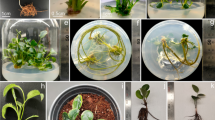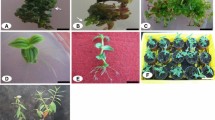Abstract
The gesneriaceous perennial plant Titanotrichum oldhamii has beautiful foliage and attractive bright yellow flowers. However, breeding of T. oldhamii by conventional sexual hybridization may be difficult because sexual reproduction of this species is very rare. In the present study, plant regeneration systems via both direct and indirect formation of adventitious shoots from leaf explants were established as the first step toward breeding T. oldhamii by using biotechnological techniques. Adventitious shoots were formed efficiently on medium containing 0.1 mg l−1 benzyladenine. Histological observation showed that shoot formation on this medium occurred directly from leaf epidermal cells without callus formation. On the other hand, leaf explants formed calluses on medium containing 0.1 mg l−1 2,4-dichlorophenoxyacetic acid. The calluses could be maintained by monthly subculturing to fresh medium of the same composition. When the calluses were transferred to plant growth regulator-free medium, they formed adventitious shoots. Directly and indirectly formed shoots rooted well on medium containing 0.1 mg l−1 indole-3-butyric acid. Plantlets thus obtained were successfully acclimatized and grew vigorously in the greenhouse. Flow cytometry analysis indicated that no variation in the ploidy level was observed in plants regenerated via direct shoot formation, whereas chromosome doubling occurred in several plants regenerated via indirect shoot formation. Regenerated plants with the same ploidy level as the mother plants showed almost the same phenotype as the mother plants, whereas chromosome-doubled plants showed apparent morphological alterations: they had small and crispate flowers, and round and deep green leaves.




Similar content being viewed by others
References
Arene L, Pellegrino C, Gudin S (1993) A comparison of the somaclonal variation level of Rosa hybrida L. cv Meirutral plants regenerated from callus or direct induction from different vegetative and embryonic tissues. Euphytica 71:83–90
Geier T (1988) In vitro chemical induction and propagation of Kohleria mutants with altered plant shape and flowering behaviour. Acta Hortic 226:687–694
Handro W (1983) Effects of some growth regulators on in vitro flowering of Streptocarpus nobilis. Plant Cell Rep 2:133–136
Jin C, Jianjun C, Richard JH (2009) Regeneration of Aeschynanthus radicans via direct somatic embryogenesis and analysis of regenerants with flow cytometry. In Vitro Cell Dev Biol Plant 45:34–43
Jin S, Mushke R, Zhu H, Tu L, Lin Z, Zhang Y, Zhan X (2008) Detection of somaclonal variation of cotton (Gossypium hirsutum) using cytogenetics, flow cytometry and molecular markers. Plant Cell Rep 27:1303–1316
Jungnickel F, Zaid S (1992) Micropropagation of African violets (Saintpaulia sp. and cvs.). In: Bajaj YPS (ed) Biotechnology in agriculture and forestry, vol. 20, high-tech. and micropropagation IV. Springer, Berlin, pp 357–395
Kaeppler SM, Kaeppler HF, Rhee Y (2000) Epigenetic aspects of somaclonal variation in plants. Plant Mol Biol 43:179–188
Karp A (1995) Somaclonal variation as a tool for crop improvement. Euphytica 85:295–302
Larkin PJ, Scowcroft WR (1981) Somaclonal variation—a novel source of variability from cell cultures for plant improvement. Theor Appl Genet 60:197–214
Lee M, Phillips RL (1988) The chromosomal basis of somaclonal variation. Annu Rev Plant Physiol Plant Mol Biol 39:413–437
Li Z-Y, Kao M-T (1998) Gesneriaceae. In: Huang T-C (ed) Flora of Taiwan, vol 4. Editorial Committee of the Flora of Taiwan, Taipei, pp 708–709
Lo KH (1997) Factors affecting shoot organogenesis in leaf disc culture of African violet. Sci Hortic 72:49–57
Lo KH, Giles KL, Sawhney VK (1997) Histological changes associated with acquisition of competence for shoot regeneration in leaf discs of Saintpaulia ionantha × confuse hybrid (African violet) cultured in vitro. Plant Cell Rep 16:421–425
Małgorzata DG (2001) Direct somatic embryogenesis as a rapid and efficient system for in vitro regeneration of Arabidopsis thaliana. Plant Cell Tiss Org Cult 60:39–46
Mithila J, Hall JC, Victor JMR, Saxena PK (2003) Thidiazuron induces shoot organogenesis at low concentrations and somatic embryogenesis at high concentrations on leaf and petiole explants of African violet (Saintpaulia ionantha Wendl.). Plant Cell Rep 21:408–414
Mohanty S, Panda MK, Subudhi E, Nayak S (2008) Plant regeneration from callus culture of Curcuma aromatica and in vitro detection of somaclonal variation through cytophotometric analysis. Biol Plant 52:783–786
Mølgaard JP, Roulund N, Deichmann V, Irgens-Møller L, Andersen SB, Farestveit B (1991) In vitro multiplication of Saintpaulia ionantha Wendl. by homogenization of tissue cultures. Sci Hortic 48:285–292
Murashige T, Skoog F (1962) A revised medium for rapid growth and bioassays with tobacco tissue cultures. Physiol Plant 15:473–497
Murata M, Orton TJ (1987) Callus initiation and regeneration capacities in Brassica species. Plant Cell Tissue Org Cult 11:111–123
Nakano M, Mii M (1993) Somatic hybridization between Dianthus chinensis and D. barbatus through protoplast fusion. Theor Appl Genet 86:1–5
Nakano M, Niimi Y, Kobayashi D, Watanabe A (1999) Adventitious shoot regeneration and micropropagation of hybrid tuberous begonia (Begonia × tuberhybrida Voss). Sci Hortic 79:245–251
Nakano M, Nomizu T, Mizunashi K, Suzuki M, Mori S, Kuwayama S, Hayashi M, Umehara H, Oka E, Kobayashi H, Asano M, Sugawara S, Takagi H, Saito H, Nakata M, Godo T, Hara Y, Amano J (2006) Somaclonal variation in Tricyrtis hirta plants regenerated from 1-year-old embryogenic callus cultures. Sci Hortic 110:366–371
Nakano M, Sakakibara T, Suzuki S, Saito H (2000a) Decrease in the regeneration potential of long-term cell suspension cultures of Lilium formosanum Wallace and its restoration by the auxin transport inhibitor, 2, 3, 5-triiodobenzoic acid. Plant Sci 158:129–137
Nakano M, Takagi H, Sugawara S, Saito T, Watanabe Y, Lu Y, Guan K, Godo T (2009) Adventitious shoot regeneration and micropropagation of Chirita flavimaculata W.T. Wang, C. eburnea Hance, and C. speciosa Kurz. Prop Ornam Plant 9:216–222
Nakano M, Watanabe Y, Hoshino Y (2000b) Histological examinations of callogenesis and adventitious embryogenesis in immature ovary culture of grapevine (Vitis vinifera L.). J Hortic Sci Biotech 75:154–160
Ohki S (1994) Scanning electron microscopy of shoot differentiation in vitro from leaf explants of the African violet. Plant Cell Tissue Org Cult 36:157–162
Saito H, Mizunashi K, Tanaka S, Adachi Y, Nakano M (2003) Ploidy estimation in Hemerocallis species and cultivars by flow cytometry. Sci Hortic 97:185–192
Scaramuzzi F, Apollonio G, D’emerico S (1999) Adventitious shoot regeneration from Sinningia speciosa leaf discs in vitro and stability of ploidy level in subcultures. In Vitro Cell Dev Biol Plant 35:217–221
Simmonds JA, Werry T (1987) Liquid-shake culture for improved micropropagation of Begonia hiemalis. HortScience 22:122–124
Vasil V, Vasil IK (1985) Isolation and maintenance of embryogenic cell suspension cultures of Gramineae. In: Vasil IK (ed) Cell culture and somatic cell genetics of plants. Academic, Orlando, pp 152–157
Wang C-N, Cronk QCB (2003) Meristem fate and bulbil formation in Titanotrichum (Gesneriaceae). Am J Bot 90:1696–1707
Wang C-N, Möller M, Cronk QCB (2004) Population genetic structure of Titanotrichum oldhamii (Gesneriaceae), a subtropical bulbiliferous plant with mixed sexual and asexual reproduction. Ann Bot 93:201–209
Wang W-T, Pan K-Y, Li Z-Y, Weitzman AL, Skog LE (1998) Gesneriaceae. In: Wu Z-Y, Raven PH (eds) Flora of China, vol 18. Science Press/Missouri Botanical Garden Press, St. Louis, pp 244–401
Author information
Authors and Affiliations
Corresponding author
Rights and permissions
About this article
Cite this article
Takagi, H., Sugawara, S., Saito, T. et al. Plant regeneration via direct and indirect adventitious shoot formation and chromosome-doubled somaclonal variation in Titanotrichum oldhamii (Hemsl.) Solereder. Plant Biotechnol Rep 5, 187–195 (2011). https://doi.org/10.1007/s11816-011-0172-5
Received:
Accepted:
Published:
Issue Date:
DOI: https://doi.org/10.1007/s11816-011-0172-5




